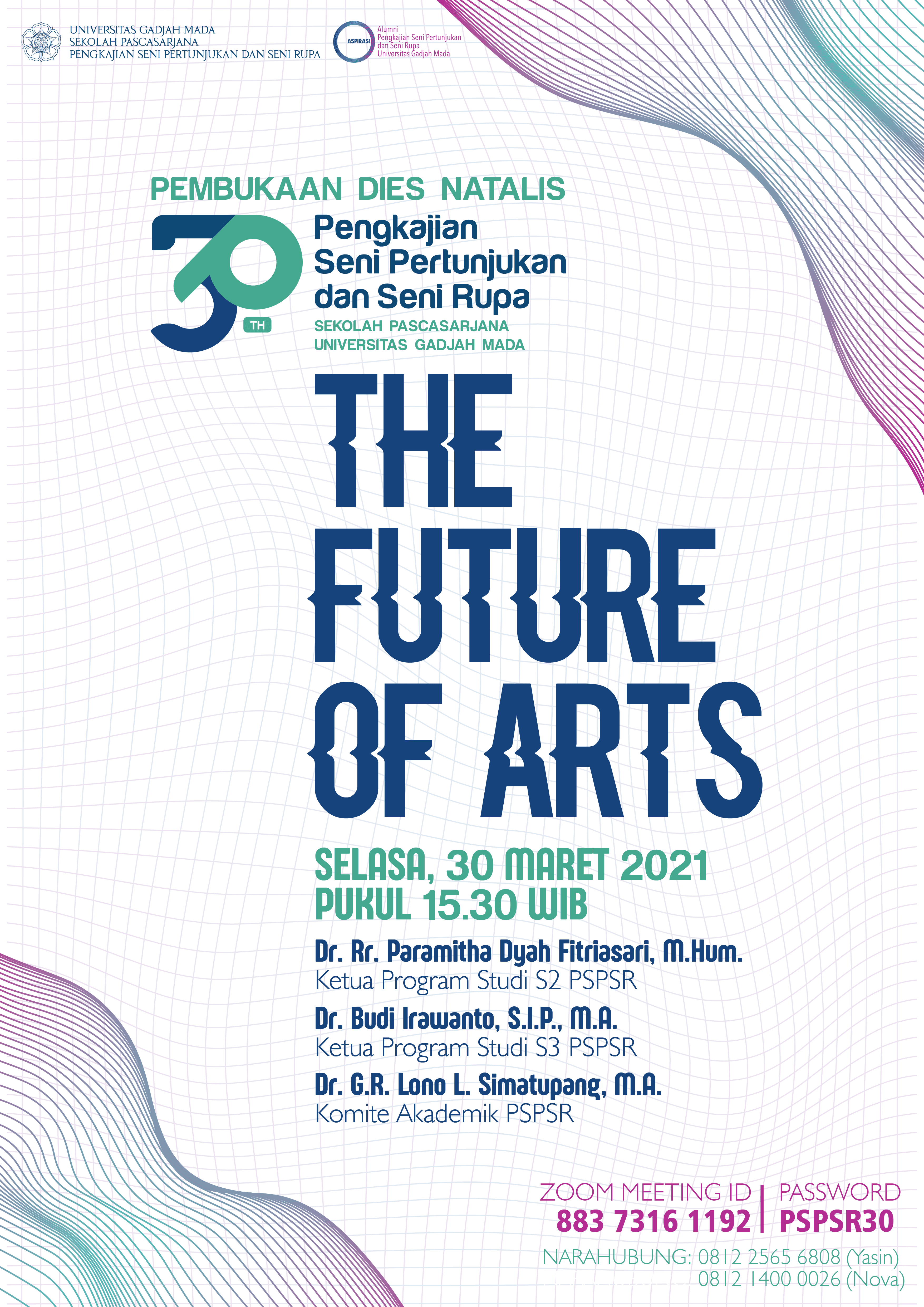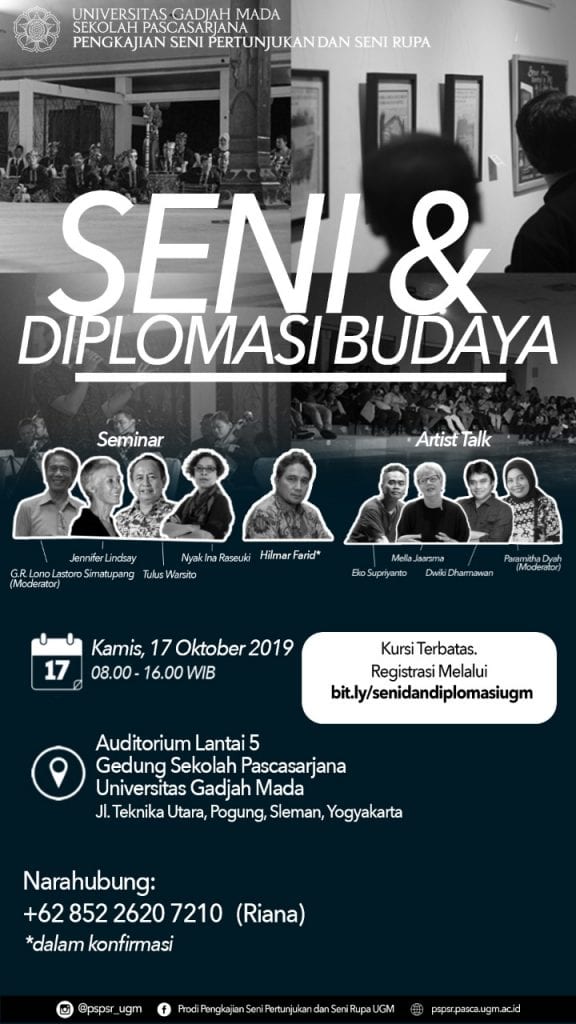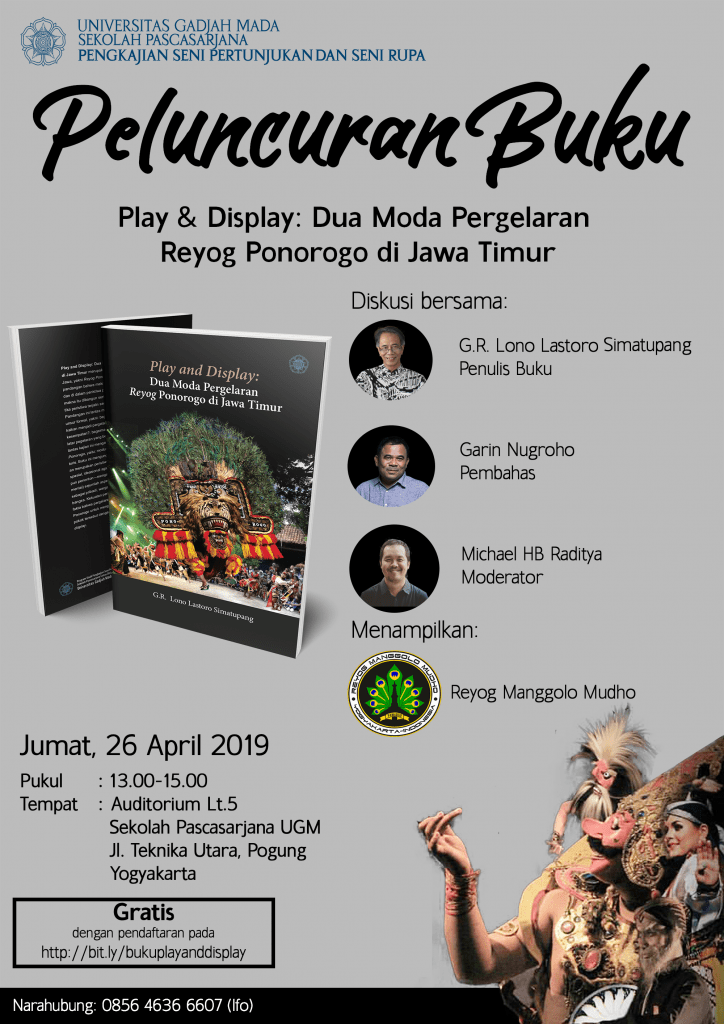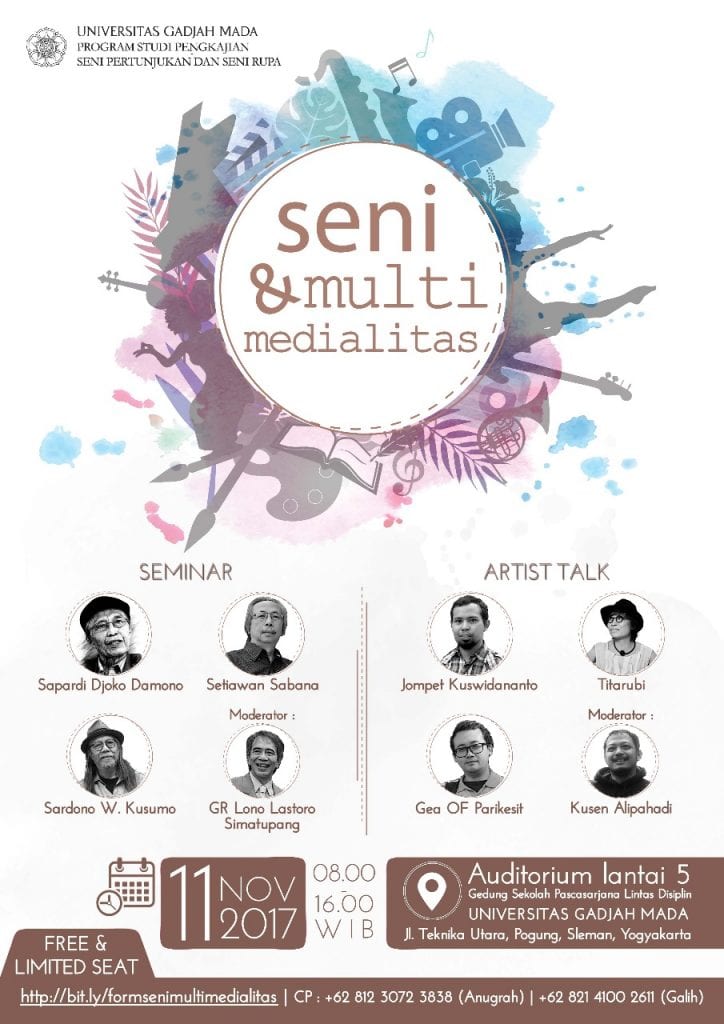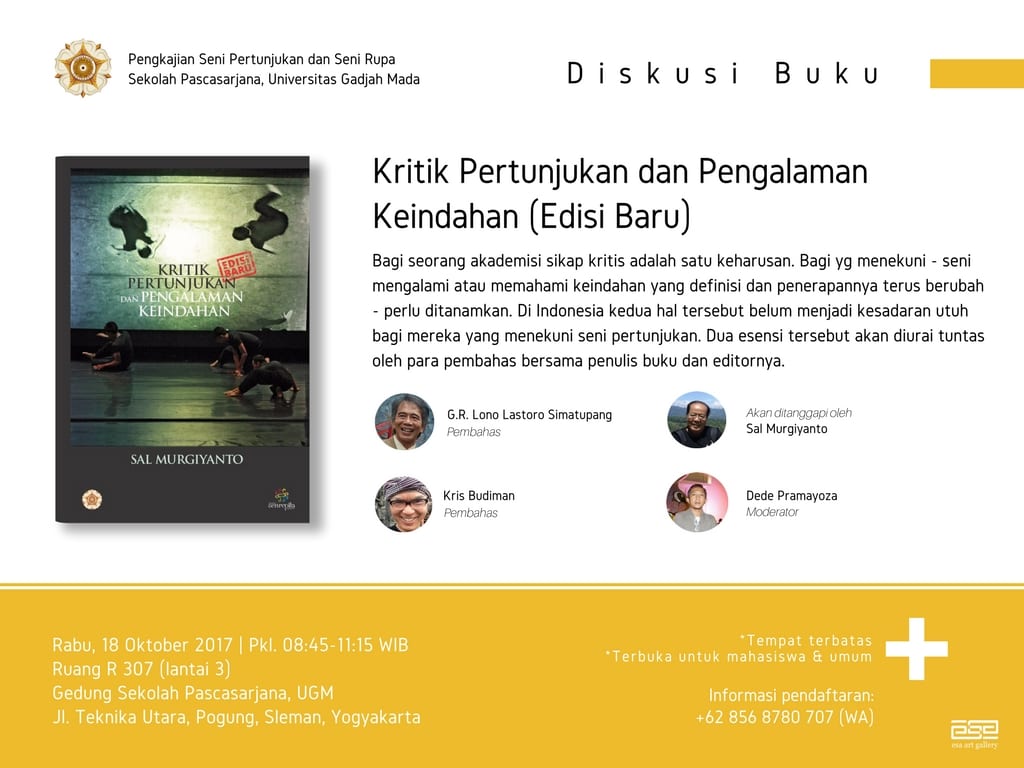The Future of Arts
“The Future of Arts” sebagai tema dies PSPSR tahun ini menggarisbawahi masa depan seni, baik dari sisi bentuk maupun posisinya, dalam konteks masyarakat kontemporer. Masa depan itu tak hanya penerusan masa kini atau proyeksi dari masa kini, melainkan terselip harapan atau kondisi yang diimajinasikan dan belum menemukan bentuknya. Selain itu, seni sesungguhnya ikut berkontribusi dalam mengukir masa depan karena seni merupakan bagian dari praktik sosial, terutama perannya dalam menciptakan dunia simbolik. Seni, kita tahu, mengusung nilai-nilai estetika yang tak hanya mengilhami, tapi juga menjadikan penghayatan hidup yang lebih intens.
Persoalan masa depan seni itu kian bertambah pelik ketika pandemi COVID-19 melanda lebih dari setahun silam dan tak kunjung usai hingga kini. Kendatipun praktik berkesenian terus berlangsung di tengah pembatasan sosial dan fisik, tak urung pandemi telah mengubah presentasi seni yang difasilitasi oleh teknologi Internet (digital). Masa pandemi telah menjadi momen kontemplatif sekaligus kreatif bagi para pelaku seni. Akibatnya, lahir moda baru penciptaan, presentasi, pewacanaan, mediasi dan sirkulasi karya seni yang mengatasi batas-batas geografis. Selain itu, masa pandemi semakin menegaskan peran teknologi yang ikut membentuk moda representasi dan presentasi karya seni serta pada gilirannya turut mentransformasi medan seni.
Meski demikian, ada sejumlah pertanyaan kritis yang bisa diajukan berkaitan dengan praktik seni di masa pandemi, antara lain:
- Apakah interaktivitas (interactivity) yang mencuat dari praktik seni di masa pandemi ini memiliki muatan relasional-nya atau lebih karena imperatif teknologis semata?
- Apakah elemen ‘bermain’ (playfulness) yang bisa ditemukan dalam ekspresi seni media baru yang berbasiskan teknologi masih mengusung semangat emansipasi (emancipation)?
- Masih relevankah berbicara tentang otonomi seni (art autonomy) di masa depan ketika teknologi yang berkelindan dengan ideologi neoliberal telah ikut mewarnai praktik berkesenian saat ini?
- Apakah mediasi terhadap liveness bisa dianggap sebagai ikhtiar mendorong pada partisipasi di kalangan penikmat seni?
Jawaban atas deretan pertanyaan tersebut, tak urung, akan membawa kita pada perbincangan ihwal relasi seni dengan masyarakat tempat seni beroperasi. Di samping itu, juga membawa pada perbincangan pada peran teknologi yang kian krusial dalam membentuk praktik seni. Tentu, teknologi mesti dipahami tidak bersifat determistik terhadap seni, namun lebih sebagai faktor yang memungkinkan bagi produksi, distribusi dan eksibisi seni.
"The Future of Arts"
Yang akan diselenggarakan secara daring pada :
🗒Selasa, 30 Maret 2021
🕞15.30-17.30 WIB
📌Zoom meeting
ARSIP SEMINAR KLIK DI SINI
Bersama :
1. Dr. Rr. Paramitha Dyah Fitriasari, M.Hum.
2. Dr. Budi Irawanto, S.I.P., M.A.
3. Dr. G.R. Lono L. Simatupang, M.A.
Atas kehadiranyya diucapkan terima kasih
Arts and Cultural Diplomacy
The cultural mission in the Indonesian homeland had been implemented after Indonesia's independence in 1945. For Sukarno, it was through culture that Indonesia could demonstrate independence, as well as its cultural diversity. On that basis, Sukarno had carried out a cultural mission by sending various artists abroad. In short, the cultural mission kept Sukarno's foreign policy agenda. Also an Indonesianist, Jennifer Lindsay also wrote that: Many cultural missions were sent abroad by President Soekarno in the 1950s and 1960s. The mission, which usually consists of dancers and musicians, is intended as an expression of "national confidence and pride" (Lindsay, 2012: 195). While agreeing with this, in her writing Barbara Hatley stated that in that era there was indeed an agenda of creating an advanced national culture for the Indonesian nation (2014: 4).
But apart from the cultural mission, our culture has also visited various countries during the colonial era. Such as the gamelan performance at the L'Exposition Universelle (Exhibition of the Universe) which was held in Paris in 1889 to commemorate the 100th anniversary of the French Revolution. It was there that the Sundanese Sari Oneng gamelan from the village of Parakan Salak, near Sukabumi was performed, among other things to accompany four dancing girls at the Mangkunegaran palace, Solo (Perlman, 1994: 512; Sorrell, 1992: 66; Wachsmann, 1973: 7; Wibsiono, 2012: 12) [3]. As a result, various exchange interactions have also become a continuous pattern, but with different agendas or goals.
Lately, similar cultural missions are still being carried out, whether linked to the government or the private sector. Even in the form of art, it has also undergone changes, from traditional arts to traditional to contemporary arts. Instead of only sending cultural missions, various other interaction activities also took place, from festivals to residencies. From this, we can see the various forms of cultural interaction that have developed but still have the aim of disseminating Indonesia, or of diplomizing Indonesian culture through the arts. However, we need to further investigate several things, such as: How is the construction of domestic and foreign diplomacy designed? How the academics and artists could read the construction of cultural diplomacy? To what extent does art have a say in determining the agenda for cultural diplomacy? How does cultural diplomacy have bargaining power for the arts? This is important to do in order to design an understanding of what cultural diplomacy would like to proclaim in the future, by looking at the past and the present. If this is done with critical power, presumably cultural diplomacy applied at home or abroad can act synergistically, so that the arts can play an important role in the design of future cultural strategies.
Therefore, we present speakers:
Keynote Speaker:
Hilmar Farid
First Session Speaker:
- Jennifer Lindsay
- Nyak Ina Raseuki
- Sincere Warsito
Moderator: G.R. Lono Lastoro Simatupang
Second Session Speaker:
- Mella Jaarsma
- Eko Supriyanto
- Dwiki Dharmawan
Moderator: Rr. Paramitha Dyah F.
Play and Display Book Discussion
Play and Display: Two Modes of the Reyog Ponorogo Performance in East Java are an analysis of the Javanese folk dance performance, namely Reyog Ponorogo. The basic premise of this study is the view that the meaning of Reyog Ponorogo is necessarily intertwined in the events of its performance, and collaboratively that is constructed and reconstructed the meaning by the participants as the events are intertwined and the performance is carried out. This view then led ua to examine the formal elements, namely: how are the elements arranged into performances in various space-time and opportunity settings?; How do participants interact in different settings? Through this search, this study affirms two modes of Reyog Ponorogo performance, namely: the presentational mode and the participatory mode. This book reveals that both modes of performance are public events with temporal, spatial, ideational framing so that Ponorogo people as actors and spectators alike experience (visually, aural, physically and mentally) a number of important aspects of their personal existence. Ponorogo community members, as well as nationals. The strength of the Reyog Ponorogo performance lies in the fact that it is a moment for Ponorogo people to experience and express these basic matters in an entertaining way, namely: play and display.
Based on the review of the book, we held a book launch by inviting:
- Garin Nugroho (Book Commenter)
- G.R. Lono Lastoro Simatupang (Book Author)
Moderator: Michael HB Raditya
Art and Multi-Mediality
Art shows the complexity of reality by presenting opportunities to penetrate the boundaries of 'commonness.' Art is creative work where the 'impossible' becomes 'possible,' the 'hidden' becomes 'visible,' the 'bad' becomes 'good,' which 'cannot' become 'may be,' and so on. However, art never simply follows interpretation or common sense of reality, but creates alternative interpretations of reality.
In art, creativity is the main thing and cannot be ignored. Nevertheless, art is not only about ideas, but always requires forms — whether visual, aural, or both — in order to be present and experienced by humans. In this case, idea and form are two dimensions that are never separated in art, nor are they always compatible.
In recent decades, the embodiment of art is not only in one medium, but in other forms that tend to be multi-media. However, in this case, the media can be interpreted as a substance that connects two or more parties (Meyer, 2008; Damono, 2012). The function of the media is to mediate, become an intermediary, a bridge for the interaction of both parties. This mediation function is carried out by various substances (letters, images, words, motion, color, etc.).
The use of more than one media substance, or the transfer from one media to another, suggests that each substance actually has capabilities and limitations in carrying out its mediating role. As a result, when art uses more than one expressive medium, or when it moves from one expressive medium to another, there is the next space for artistic creativity. Likewise so on.
In this case, multi-mediality is not about changing forms, but understanding a way of working creativity that comes from previous creativity, whether it is reinterpretation, addition or subtraction. Multi-mediality is a "risky" subject, because the work of creativity has quite a burden on previous creativity, but on the other hand it creates a charm because it produces new interpretations that are adapted to the contextual.
Furthermore, creativity and tasfir will provide a space for understanding or meaning of works of art that can be increased, stable, or decreased. With the practice of multi-mediality, the meaning of art continues to develop in accordance with the spirit of the times. Starting from this tug of war, we believe that the discussion of art mediums continues to develop, in fact, we note several things that are quite important in multi-mediality, namely: changing the medium, creativity, meaning, and context.
In embodying this logic, we invite speakers, as follows:
First Session Seminar
- Sapardi Djoko Damono
- Sardono W. Kusumo
- Setiawan Sabana
Moderator: G.R. Lono Lastoro Simatupang
Second Session Seminar
- Jompet Kuswidananto
- Titarubi
- Gea OF Parikesit
Moderator: Alipahadi Sills
On this basis, we would like to discuss in more depth about art and multi-mediality. For us, discussing the medium in art is an interesting discussion, especially in the examples of works that refer to art practices based on multi-mediality.
"Performing Arts Criticism and Experience of Beauty" book launching and discussion
The Performing Arts and Visual Arts Study Program, Interdisciplinary Postgraduate School, UGM welcomes the publication of this New Edition of Kritik Seni Pertunjukan dan Pengalaman Keindahan The book written by Sal Murgiyanto - a performing arts practitioner as well as an academic who has crossed the arena of performing arts and education - contains a number of criticisms of performing arts, particularly dance. In this book, Sal's expertise in raging inner experiences when experiencing performing arts - both as an audience and as an actor, relates it to heaps of other performing arts experiences, rearranges it as a sequence of thoughts, dialogues it. about academic discourse, and put it into pious writing. Thanks to the discussion process that involved such intense physical and mental activity, the feelings that raged during the show were no longer wrapped in personal experience, nor did they evaporate in the conversation after the show. Through this critical writing, the process of thinking and feeling takes a new form in the form of reflective writing that is ready to meet its readers.
This book is not only useful for performing arts academics, but also for both performing arts practitioners and those involved in organizing performances. For performing arts academics, this book provides examples of applying various important perspectives in performing arts studies to discourse performing arts. Various traces of discourse on performance studies, dance studies, embodiment, aesthetics, and existential phenomenology can easily be recognized here and there. However, this book is not a theoretical contemplation to criticize academic discourse in the field of performing arts studies. This book is not a theoretical critique of the performing arts, but a critique of the performing arts. Instead of presenting reasoning at the abstract level, this book rests on careful and intelligent descriptions of a number of performance events. Some of Sal's writings in this book can be said to be characterized by critical ethnography. We consider this ethnographic content to be useful for performing arts practitioners and event organizers who are less interested in the conceptual / theoretical dimension. Here, the accuracy of the description of performance events is strongly supported by Pak Sal's familiarity with the world of performing arts. The performance descriptions can be placed as "sparring partners" for performing arts practitioners and organizers. Through it, performing arts practitioners and organizers can draw on several aesthetic considerations, like the dramaturgic role in performing arts.
Indeed, the role of criticism is to reconcile academic discourse with the realm of practice, both for the purpose of developing knowledge and for the creation of new practices. This book successfully demonstrates this. In such direction of art criticism, we view this book as too valuable not to be republished. Hopefully the publication of this New Edition of Kritik Seni Pertunjukan dan Pengalaman Keindahan will be of benefit to efforts to strengthen performing arts study programs in Indonesia.
This book is discussed by:
- G.R. Lono Lastoro Simatupang
- Kris Budiman
- Sal Murgiyanto (Responders)
Moderator: Dede Pramayoza
Seminar The Power of Art
Coinciding with the silver party of the UGM Performing Arts and Visual Arts Study Program, the committee organized a number of activities with the theme “Daya Seni” or "The Power of Arts." A series of activities will be held from May to December 2016, in the form of scientific speeches, receptions, discussions, seminars, to exhibitions and festivals. Whether we realize it or not, hidden or expressed, acknowledged or denied, art is present in almost all areas of human life; past, present, and future, and in any corner of the world. The presence of art in many aspects of life shows that art has an irreplaceable role in human life as a person, society, nation and state. Realizing this, the 25th anniversary of the PSPSR Study Program has the theme "Art Power" or "The Power of Arts" as the umbrella theme for the entire series of activities.
Artistic power is widely understood as the ability inherent in the creative process, creative form, as well as the creative consumption of art symptoms / events. The abilities at each stage of the production-consumption-product chain are not limited to solace, economic power, or attractiveness, but also spiritual power, healing power, thinking power, and political power. Through art symptoms / events, the fluid and vague experiences of human daily life get various thematic focuses for various purposes. Art does not merely represent something that is outside of itself, art itself is a presentation of the reality of life that is not / rarely revealed clearly and strongly in human daily life: art is the creation of reality.
Based on naration, this seminar invited three speakers, as follows:
- Prof. Bambang Sugiharto
- Dr. Paul Rae3. Prof. Dr. Friedrich von Borries
Moderator: Dr. G.R. Lono Lastoro Simatupang, M.A.
Arts and Beyond Conference
Art practice in Indonesia is growing rapidly in recent times. Art studies content is no longer limited to the field of art, but reaches non-art areas. Various non-artistic aspects and perspectives are also the main considerations in artistic practice. Awareness of various factors, such as: economy, religion, technology, law, gender, education, politics, health, etc., becomes a contextual stimulation in a work (textual). Openness of views on art is not only seen in the condition that it changes from supporting aspects to become the main perspective.
This does not only happen and has an impact on the artistic community, but also has a big influence on the academic community. The trend or trend of academic perspectives which discourse art from the viewpoints of various disciplines has also become a trend of academics lately. From this, it has been manifested that art, both in the field of practice and in studies, has undergone significant development with non-artistic considerations in analyzing and creating works of art.
"Arts and Beyond" will discuss specifically about:
- Correlation between multidisciplinary and art,
- Art practices that do not limit themselves to mere artistic fields, but also reach non-artistic areas,
- The trend / trend of academic perspectives which discourse art from the viewpoints of various disciplines,
- Openness of view to art that does not only refer to practice as the main perspective,
- Art friction with other perspectives in discussing art.
Starting from this matter, we have attempted to explore the perspective landscape which has become a topic of discussion in various artistic practices and discussions on art. Arts and Beyond, is our offer to discuss textual and contextual issues that occur in the field of practice and study.
At this conference, two speakers were involved, as follows:
- Prof. Matthew Isaac Cohen
- Dr. Sal Murgiyanto, M.A.
Moderator: Dr. G.R. Lono Lastoro Simatupang, M.A.
Political Arts - Political Arts
The raised topic was "Political Arts and Political Arts". It is a discussion of the relationship between texts and contextuals that correlates with art in politics and vice versa. The phenomena that culminate in the General Election become big questions regarding the position of art itself. Art in politics is sometimes used as media and tools in politics itself. It is interesting to see the extent of the position of art.
The hope is that the material and information presented can provide insight to all lines. Both in the form of general and specific discussions related to this matter and can be useful for all groups. Revealing the relationship with the sciences in art. This seminar can be a reflection material for every activist, observer, and lover of art to art phenomena that occur.
In this seminar, we invite:
First Session Seminar
- Djaduk Ferianto
- Samuel Indratma
Moderator: Kris Budiman
Second Session Seminar
- Prof. Rachmi Diyah Larasati
- Antariksa
Moderator: G.R. Lono Lastoro Simatupang

